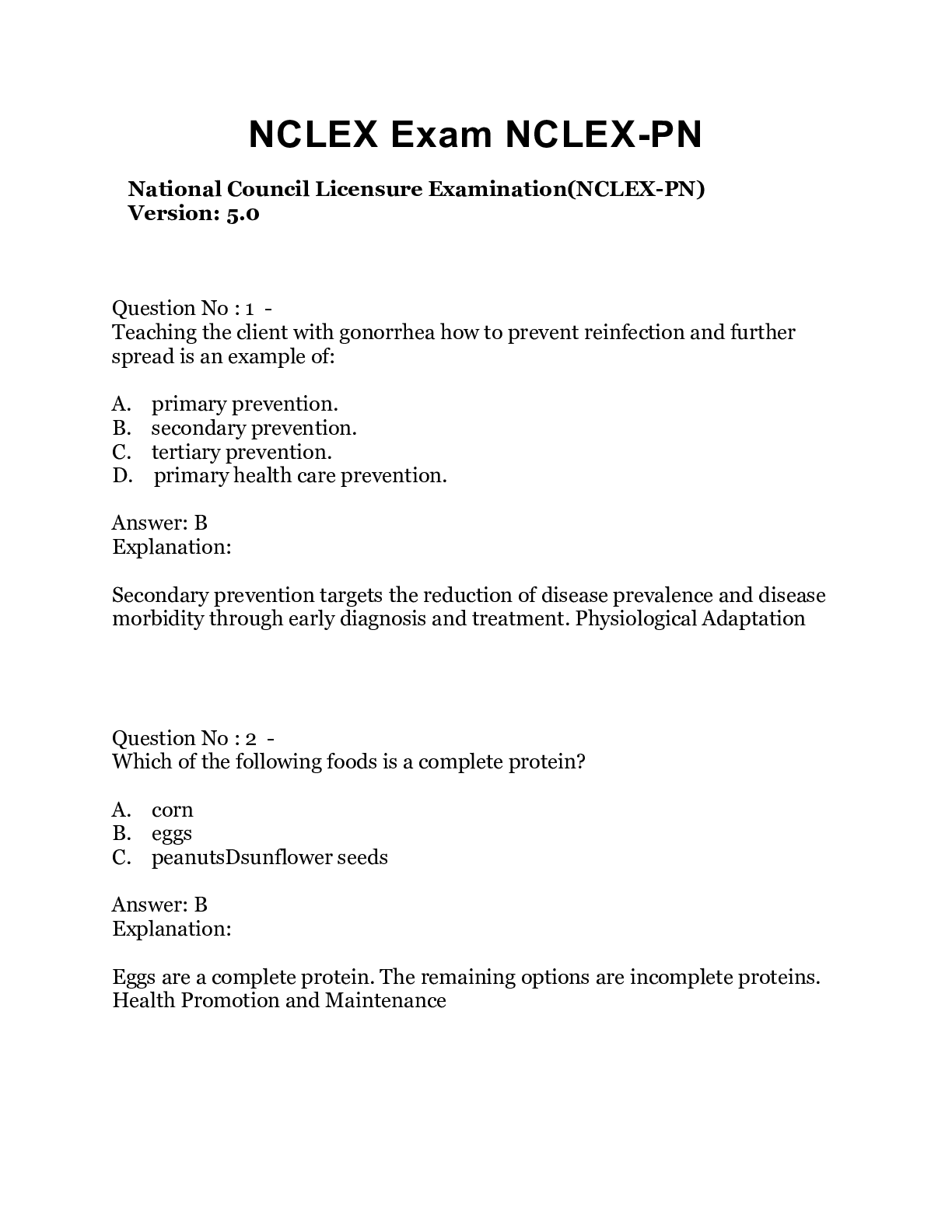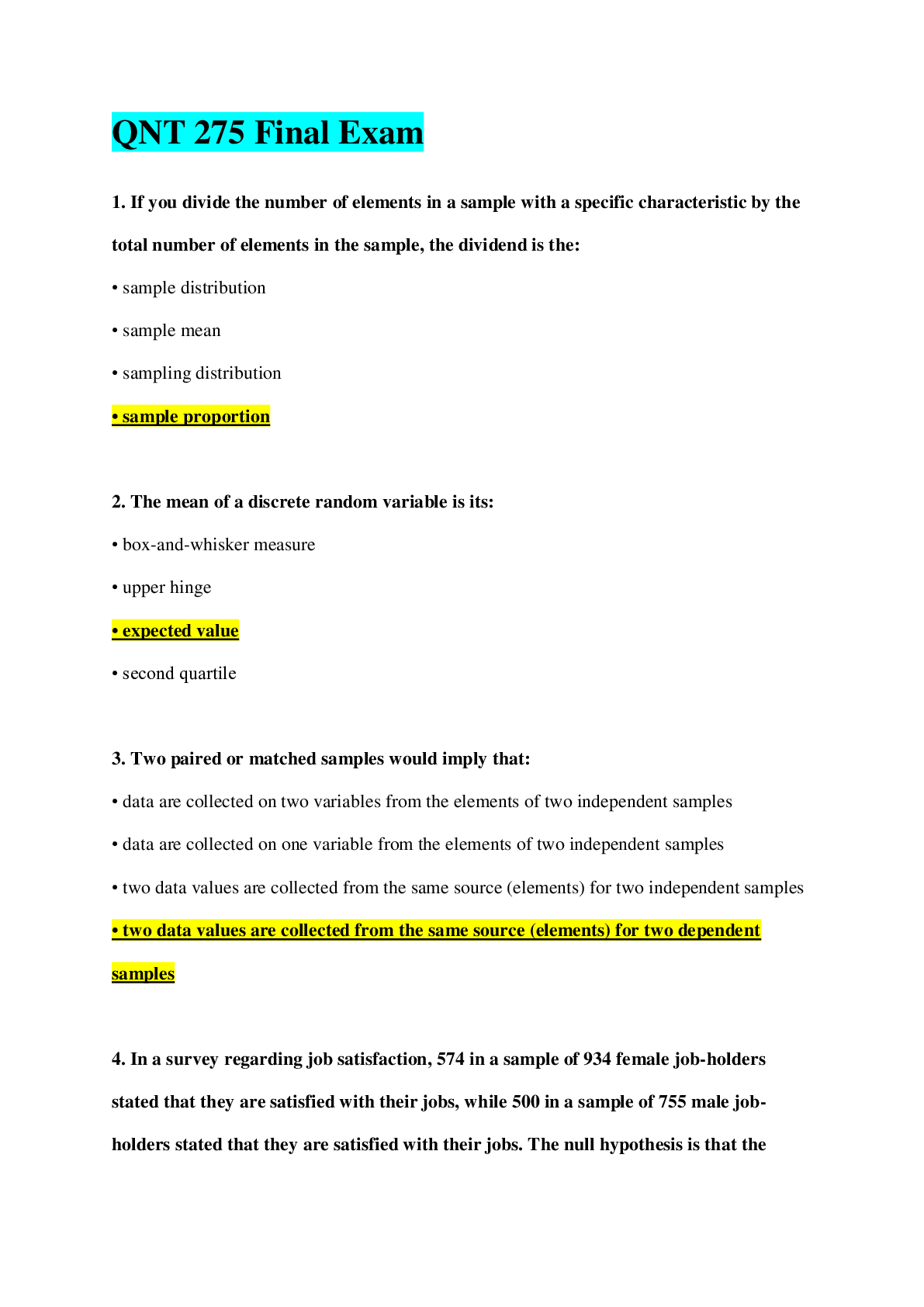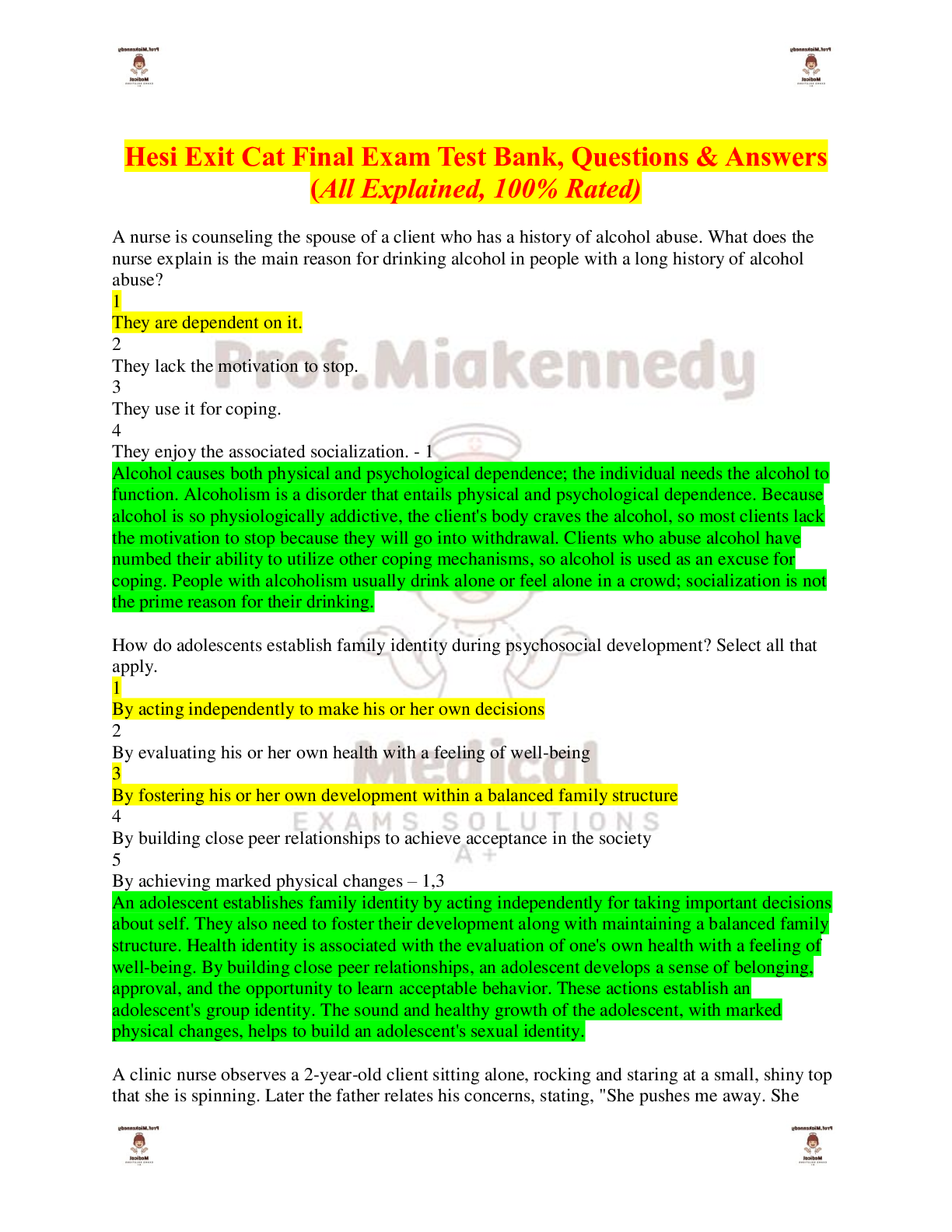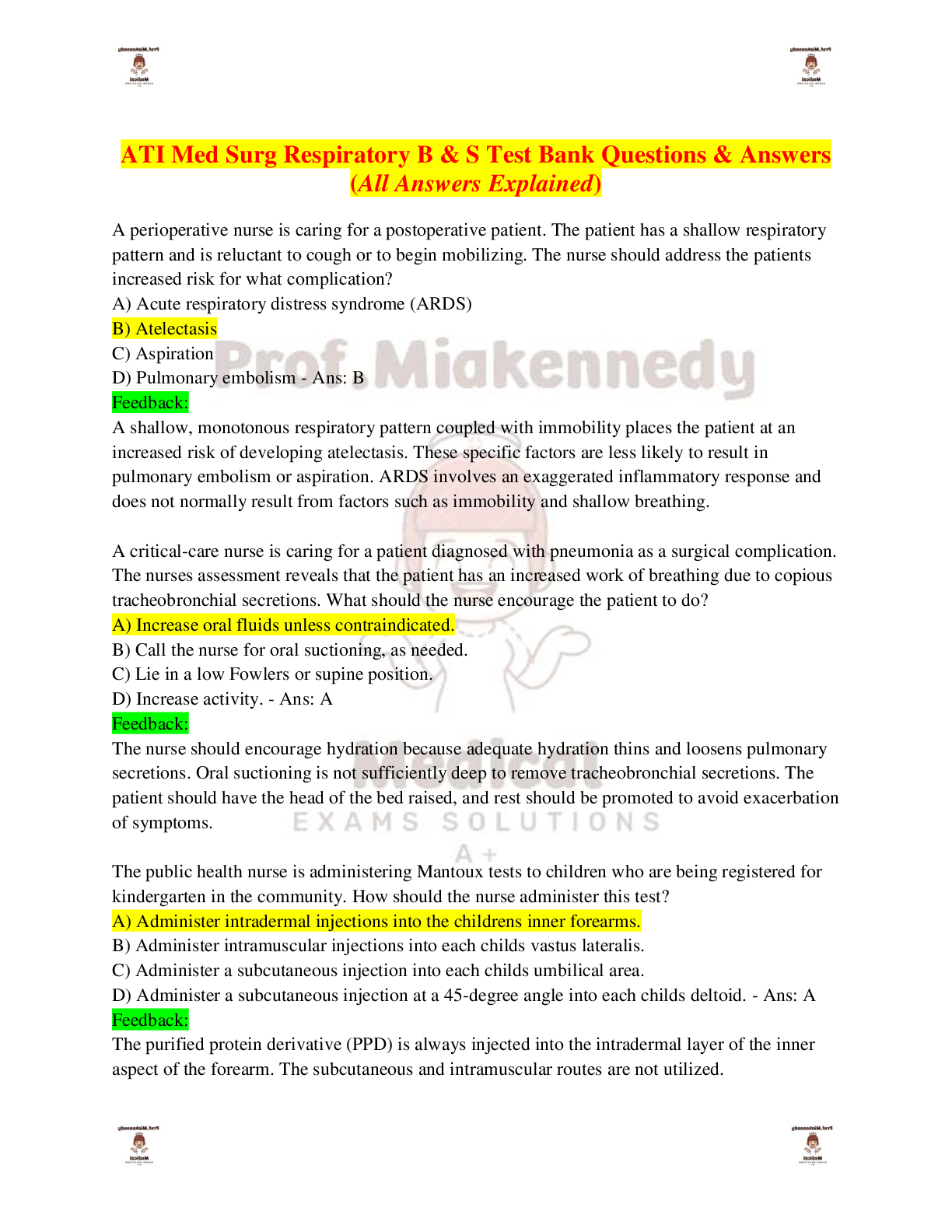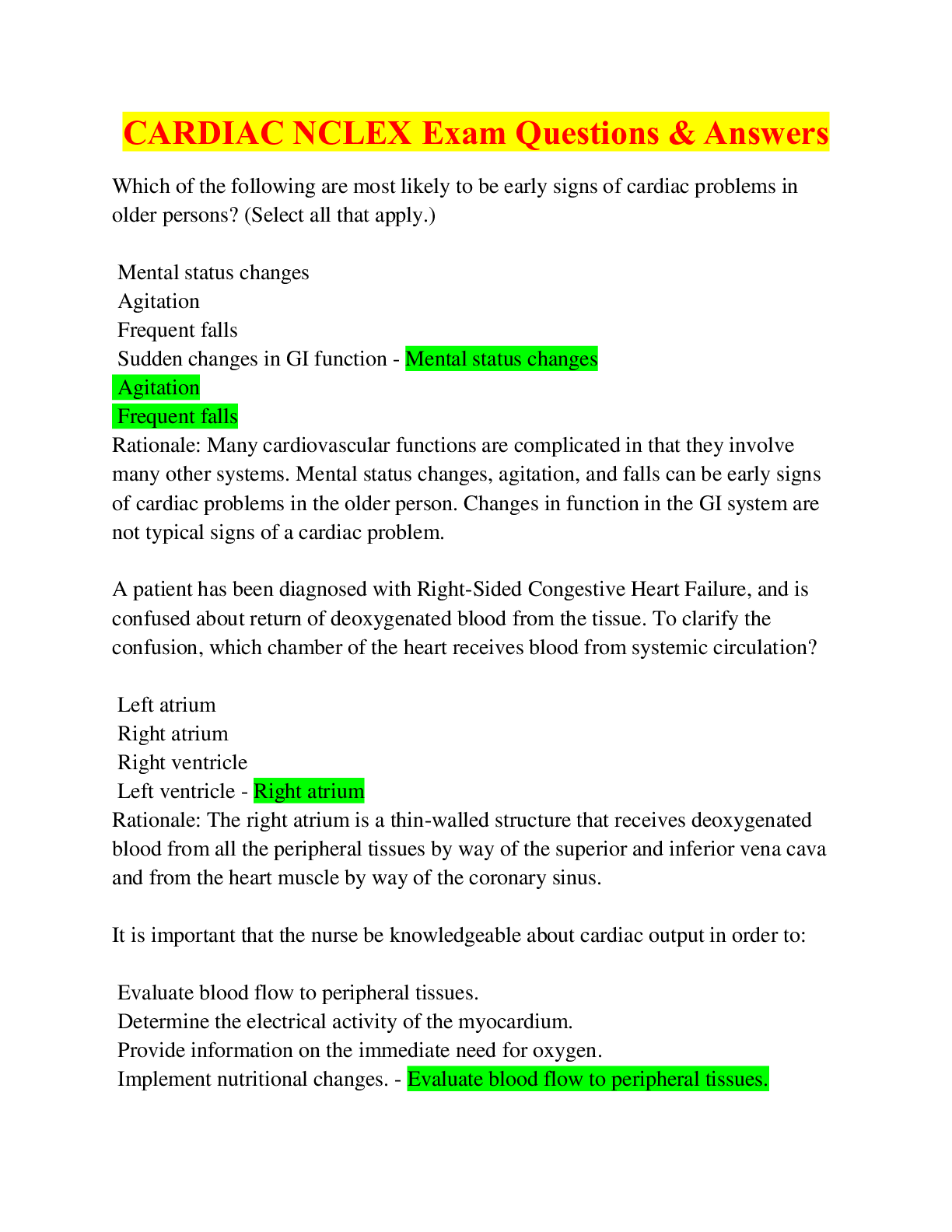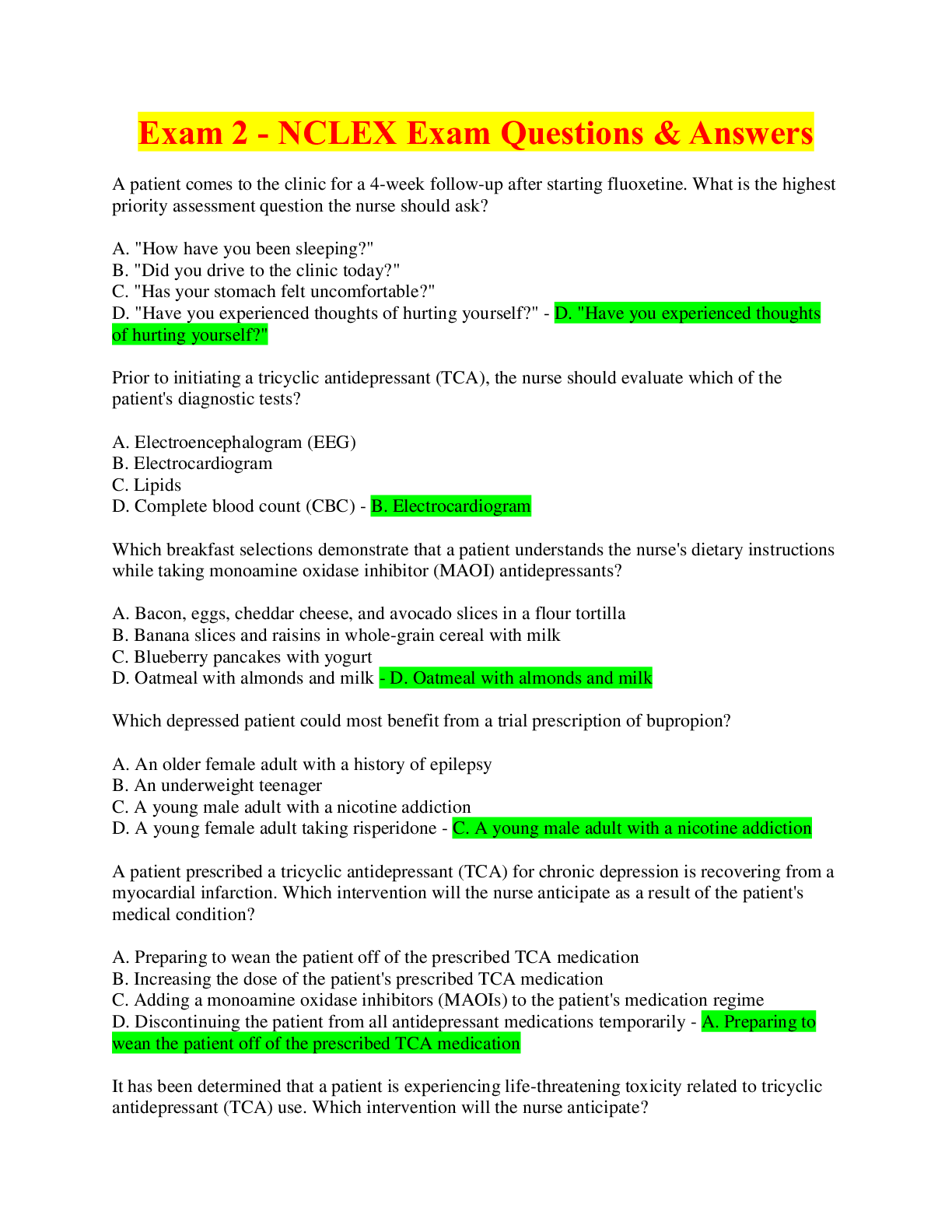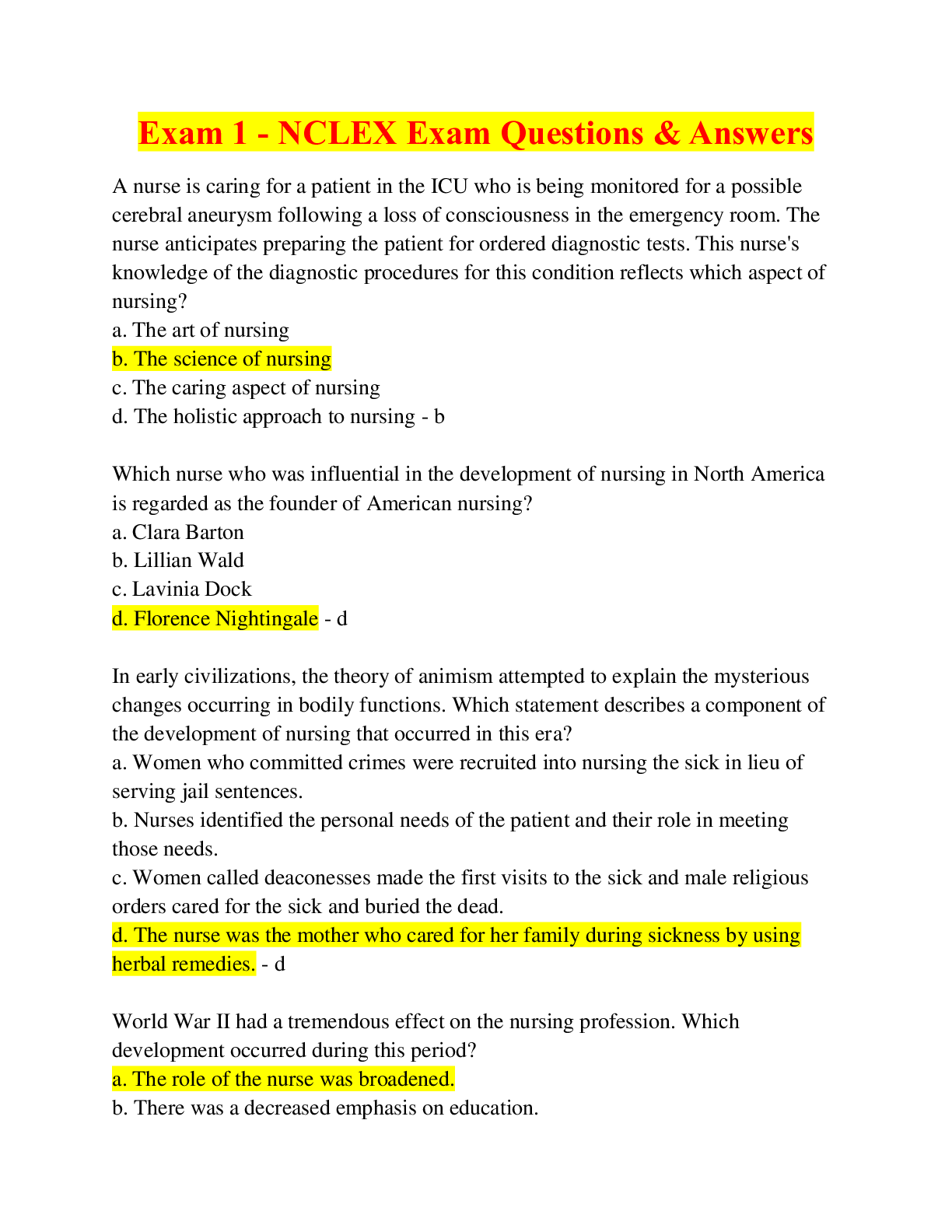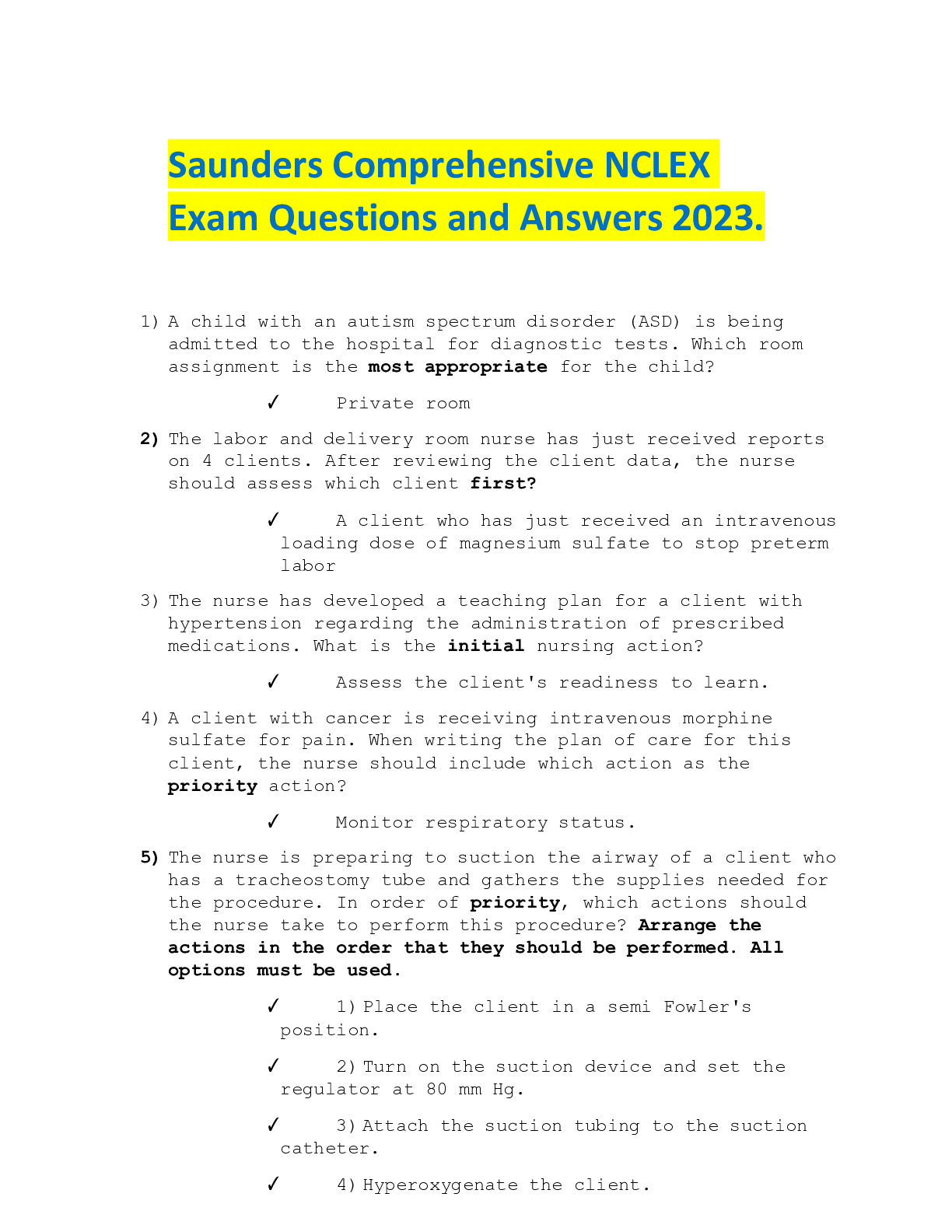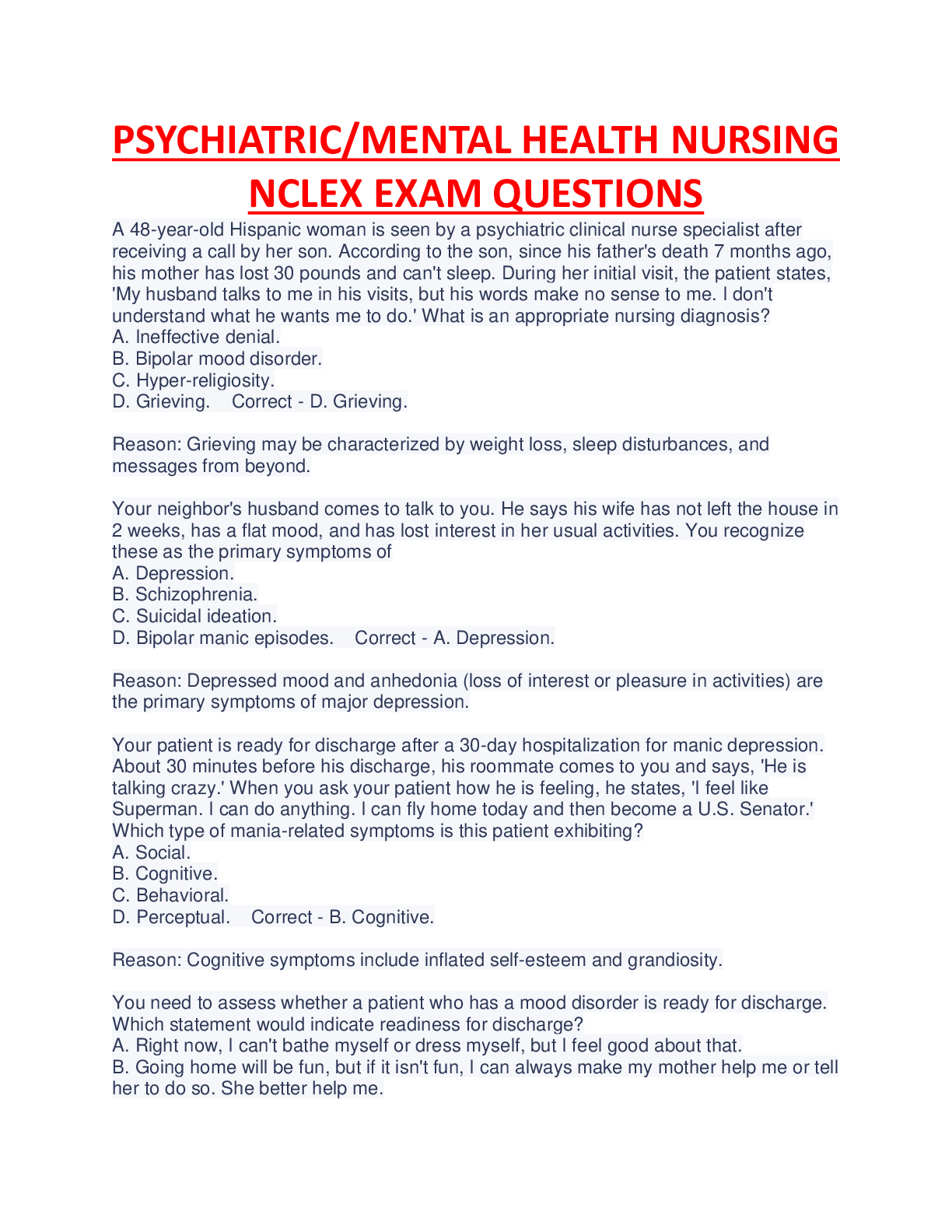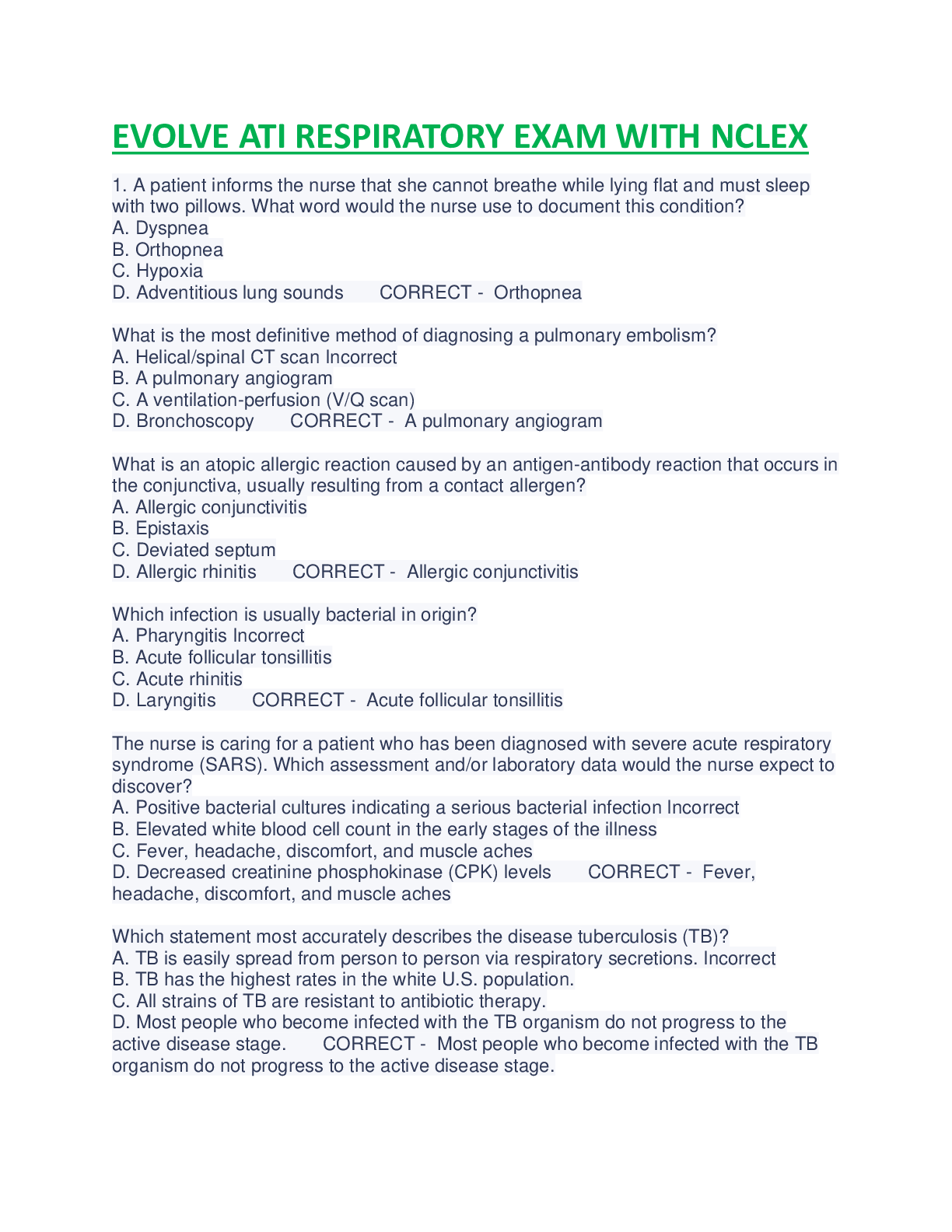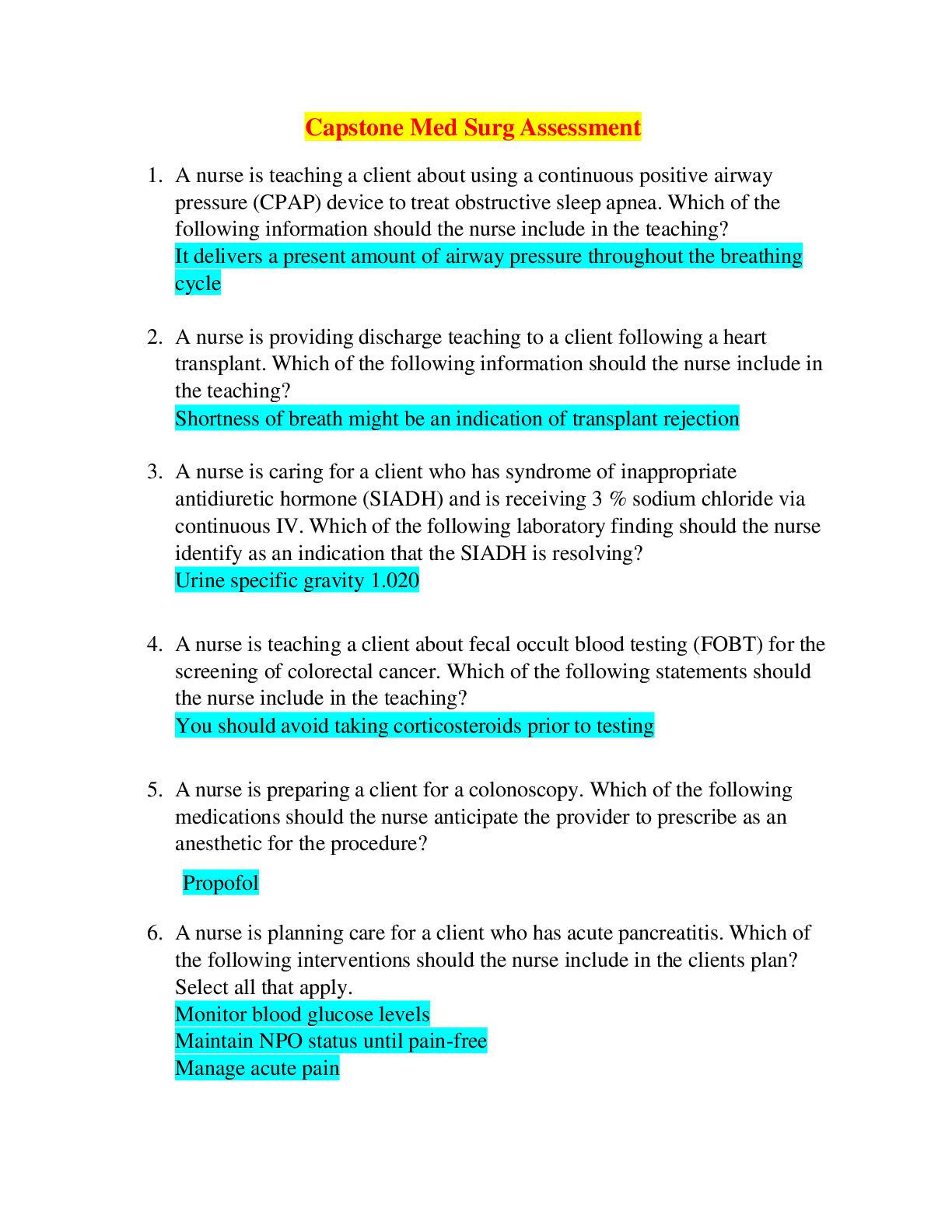NURSING. > EXAM > NCLEX Style Questions Burns, Med Surg - Burns NCLEX Exam Questions & Answers (All Answers Explained! (All)
NCLEX Style Questions Burns, Med Surg - Burns NCLEX Exam Questions & Answers (All Answers Explained!)
Document Content and Description Below
NCLEX Style Questions Burns, Med Surg - Burns NCLEX Exam Questions & Answers (All Answers Explained!)-When assessing a patient who spilled hot oil on the right leg and foot, the nurse notes that the s... kin is dry, pale, hard skin. The patient states that the burn is not painful. What term would the nurse use to document the burn depth? a. First-degree skin destruction b. Full-thickness skin destruction c. Deep partial-thickness skin destruction d. Superficial partial-thickness skin destruction - ANS: B With full-thickness skin destruction, the appearance is pale and dry or leathery and the area is painless because of the associated nerve destruction. Erythema, swelling, and blisters point to a deep partial-thickness burn. With superficial partial-thickness burns, the area is red, but no blisters are present. First-degree burns exhibit erythema, blanching, and pain On admission to the burn unit, a patient with an approximate 25% total body surface area (TBSA) burn has the following initial laboratory results: Hct 58%, Hgb 18.2 mg/dL (172 g/L), serum K+ 4.9 mEq/L (4.8 mmol/L), and serum Na+ 135 mEq/L (135 mmol/L). Which action will the nurse anticipate taking now? a. Monitor urine output every 4 hours. b. Continue to monitor the laboratory results. c. Increase the rate of the ordered IV solution. d. Type and crossmatch for a blood transfusion. - ANS: C The patient's laboratory data show hemoconcentration, which may lead to a decrease in blood flow to the microcirculation unless fluid intake is increased. Because the hematocrit and hemoglobin are elevated, a transfusion is inappropriate, although transfusions may be needed after the emergent phase once the patient's fluid balance has been restored. On admission to a burn unit, the urine output would be monitored more often than every 4 hours; likely every1 hour. A patient is admitted to the burn unit with burns to the head, face, and hands. Initially, wheezes are heard, but an hour later, the lung sounds are decreased and no wheezes are audible. What is the best action for the nurse to take? a. Encourage the patient to cough and auscultate the lungs again. b. Notify the health care provider and prepare for endotracheal intubation. c. Document the results and continue to monitor the patient's respiratory rate. d. Reposition the patient in high-Fowler's position and reassess breath sounds. - ANS: B The patient's history and clinical manifestations suggest airway edema and the health care provider should be notified immediately, so that intubation can be done rapidly. Placing the patient in a more upright position or having the patient cough will not address the problem of airway edema. Continuing to monitor is inappropriate because immediate action should occur A patient with severe burns has crystalloid fluid replacement ordered using the Parkland formula. The initial volume of fluid to be administered in the first 24 hours is 30,000 mL. The initial rate of administration is 1875 mL/hr. After the first 8 hours, what rate should the nurse infuse the IV fluids? a. 350 mL/hour b. 523 mL/hour c. 938 mL/hour d. 1250 mL/hour - ANS: C Half of the fluid replacement using the Parkland formula is administered in the first 8 hours and the other half over the next 16 hours. In this case, the patient should receive half of the initial rate, or 938 mL/hr. During the emergent phase of burn care, which assessment will be most useful in determining whether the patient is receiving adequate fluid infusion? a. Check skin turgor. b. Monitor daily weight. c. Assess mucous membranes. d. Measure hourly urine output. - ANS: D When fluid intake is adequate, the urine output will be at least 0.5 to 1 mL/kg/hour. The patient's weight is not useful in this situation because of the effects of third spacing and evaporative fluid loss. Mucous membrane assessment and skin turgor also may be used, but they are not as adequate in determining that fluid infusions are maintaining adequate perfusion. A patient has just been admitted with a 40% total body surface area (TBSA) burn injury. To maintain adequate nutrition, the nurse should plan to take which action? a. Insert a feeding tube and initiate enteral feedings. b. Infuse total parenteral nutrition via a central catheter. c. Encourage an oral intake of at least 5000 kcal per day. d. Administer multiple vitamins and minerals in the IV solution. - ANS: A Enteral feedings can usually be initiated during the emergent phase at low rates and increased over 24 to 48 hours to the goal rate. During the emergent phase, the patient will be unable to eat enough calories to meet nutritional needs and may have a paralytic ileus that prevents adequate nutrient absorption. Vitamins and minerals may be administered during the emergent phase, but these will not assist in meeting the patient's caloric needs. Parenteral nutrition increases the infection risk, does not help preserve gastrointestinal function, and is not routinely used in burn patients. While the patient's full-thickness burn wounds to the face are exposed, what is the best nursing action to prevent cross contamination? a. Use sterile gloves when removing old dressings. b. Wear gowns, caps, masks, and gloves during all care of the patient. c. Administer IV antibiotics to prevent bacterial colonization of wounds. d. Turn the room temperature up to at least 70° F (20° C) during dressing changes. - ANS: B Use of gowns, caps, masks, and gloves during all patient care will decrease the possibility of wound contamination for a patient whose burns are not covered. When removing contaminated dressings and washing the dirty wound, use nonsterile, disposable gloves. The room temperature should be kept at approximately 85° F for patients with open burn wounds to prevent shivering. Systemic antibiotics are not well absorbed into deep burns because of the lack of circulation. A nurse is caring for a patient who has burns of the ears, head, neck, and right arm and hand. The nurse should place the patient in which position? a. Place the right arm and hand flexed in a position of comfort. b. Elevate the right arm and hand on pillows and extend the fingers. c. Assist the patient to a supine position with a small pillow under the head. d. Position the patient in a side-lying position with rolled towel under the neck. - ANS: B The right hand and arm should be elevated to reduce swelling and the fingers extended to avoid flexion contractures (even though this position may not be comfortable for the patient). The patient with burns of the ears should not use a pillow for the head because this will put pressure on the ears, and the pillow may stick to the ears. Patients with neck burns should not use a pillow because the head should be maintained in an extended position in order to avoid contractures. A patient with circumferential burns of both legs develops a decrease in dorsalis pedis pulse strength and numbness in the toes. Which action should the nurse take? a. Notify the health care provider. b. Monitor the pulses every 2 hours. c. Elevate both legs above heart level with pillows. d. Encourage the patient to flex and extend the toes on both feet. - ANS: A The decrease in pulse in a patient with circumferential burns indicates decreased circulation to the legs and the need for an escharotomy. Monitoring the pulses is not an adequate response to the decrease in circulation. Elevating the legs or increasing toe movement will not improve the patient's circulation Esomeprazole (Nexium) is prescribed for a patient who incurred extensive burn injuries 5 days ago. Which nursing assessment would best evaluate the effectiveness of the medication? a. Bowel sounds b. Stool frequency c. Abdominal distention d. Stools for occult blood - ANS: D H2 blockers and proton pump inhibitors are given to prevent Curling's ulcer in the patient who has suffered burn injuries. Proton pump inhibitors usually do not affect bowel sounds, stool frequency, or appetite The nurse is reviewing the medication administration record (MAR) on a patient with partial-thickness burns. Which medication is best for the nurse to administer before scheduled wound debridement? a. Ketorolac (Toradol) b. Lorazepam (Ativan) c. Gabapentin (Neurontin) d. Hydromorphone (Dilaudid) - ANS: D Opioid pain medications are the best choice for pain control. The other medications are used as adjuvants to enhance the effects of opioids. A young adult patient who is in the rehabilitation phase after having deep partial-thickness face and neck burns has a nursing diagnosis of disturbed body image. Which statement by the patient indicates that the problem is resolving? a. "I'm glad the scars are only temporary." b. "I will avoid using a pillow, so my neck will be OK." c. "I bet my boyfriend won't even want to look at me anymore." d. "Do you think dark beige makeup foundation would cover this scar on my cheek?" - ANS: D The willingness to use strategies to enhance appearance is an indication that the disturbed body image is resolving. Expressing feelings about the scars indicates a willingness to discuss appearance, but not resolution of the problem. Because deep partial-thickness burns leave permanent scars, a statement that the scars are temporary indicates denial rather than resolution of the problem. Avoiding using a pillow will help prevent contractures, but it does not address the problem of disturbed body image The nurse caring for a patient admitted with burns over 30% of the body surface assesses that urine output has dramatically increased. Which action by the nurse would best ensure adequate kidney function? a. Continue to monitor the urine output. b. Monitor for increased white blood cells (WBCs). c. Assess that blisters and edema have subsided. d. Prepare the patient for discharge from the burn unit. - ANS: A The patient's urine output indicates that the patient is entering the acute phase of the burn injury and moving on from the emergent stage. At the end of the emergent phase, capillary permeability normalizes and the patient begins to diurese large amounts of urine with a low specific gravity. Although this may occur at about 48 hours, it may be longer in some patients. Blisters and edema begin to resolve, but this process requires more time. White blood cells may increase or decrease, based on the patient's immune status and any infectious processes. The WBC count does not indicate kidney function. The patient will likely remain in the burn unit during the acute stage of burn injury A patient with burns covering 40% total body surface area (TBSA) is in the acute phase of burn treatment. Which snack would be best for the nurse to offer to this patient? a. Bananas b. Orange gelatin c. Vanilla milkshake d. Whole grain bagel - ANS: C A patient with a burn injury needs high protein and calorie food intake, and the milkshake is the highest in these nutrients. The other choices are not as nutrient-dense as the milkshake. Gelatin is likely high in sugar. The bagel is a good carbohydrate choice, but low in protein. Bananas are a good source of potassium, but are not high in protein and calories. A patient has just arrived in the emergency department after an electrical burn from exposure to a high-voltage current. What is the priority nursing assessment? a. Oral temperature b. Peripheral pulses c. Extremity movement d. Pupil reaction to light - ANS: C All patients with electrical burns should be considered at risk for cervical spine injury, and assessments of extremity movement will provide baseline data. The other assessment data are also necessary but not as essential as determining the cervical spine status An employee spills industrial acids on both arms and legs at work. What is the priority action that the occupational health nurse at the facility should take? a. Remove nonadherent clothing and watch. b. Apply an alkaline solution to the affected area. c. Place cool compresses on the area of exposure. d. Cover the affected area with dry, sterile dressings. - ANS: A With chemical burns, the initial action is to remove the chemical from contact with the skin as quickly as possible. Remove nonadherent clothing, shoes, watches, jewelry, glasses, or contact lenses (if face was exposed). Flush chemical from wound and surrounding area with copious amounts of saline solution or water. Covering the affected area or placing cool compresses on the area will leave the chemical in contact with the skin. Application of an alkaline solution is not recommended. A patient who has burns on the arms, legs, and chest from a house fire has become agitated and restless 8 hours after being admitted to the hospital. Which action should the nurse take first? a. Stay at the bedside and reassure the patient. b. Administer the ordered morphine sulfate IV. c. Assess orientation and level of consciousness. d. Use pulse oximetry to check the oxygen saturation. - ANS: D Agitation in a patient who may have suffered inhalation injury might indicate hypoxia, and this should be assessed by the nurse first. Administration of morphine may be indicated if the nurse determines that the agitation is caused by pain. Assessing level of consciousness and orientation is also appropriate but not as essential as determining whether the patient is hypoxemic. Reassurance is not helpful to reduce agitation in a hypoxemic patient A patient arrives in the emergency department with facial and chest burns caused by a house fire. Which action should the nurse take first? a. Auscultate the patient's lung sounds. b. Determine the extent and depth of the burns. c. Infuse the ordered lactated Ringer's solution. d. Administer the ordered hydromorphone (Dilaudid). - ANS: A A patient with facial and chest burns is at risk for inhalation injury, and assessment of airway and breathing is the priority. The other actions will be completed after airway management is assured. A patient with extensive electrical burn injuries is admitted to the emergency department. Which prescribed intervention should the nurse implement first? a. Assess oral temperature. b. Check a potassium level. c. Place on cardiac monitor. d. Assess for pain at contact points. - ANS: C After an electrical burn, the patient is at risk for fatal dysrhythmias and should be placed on a cardiac monitor. Assessing the oral temperature is not as important as assessing for cardiac dysrhythmias. Checking the potassium level is important. However, it will take time before the laboratory results are back. The first intervention is to place the patient on a cardiac monitor and assess for dysrhythmias, so that they can be treated if occurring. A decreased or increased potassium level will alert the nurse to the possibility of dysrhythmias. The cardiac monitor will alert the nurse immediately of any dysrhythmias. Assessing for pain is important, but the patient can endure pain until the cardiac monitor is attached. Cardiac dysrhythmias can be lethal. Eight hours after a thermal burn covering 50% of a patient's total body surface area (TBSA) the nurse assesses the patient. Which information would be a priority to communicate to the health care provider? a. Blood pressure is 95/48 per arterial line. b. Serous exudate is leaking from the burns. c. Cardiac monitor shows a pulse rate of 108. d. Urine output is 20 mL per hour for the past 2 hours. - ANS: D The urine output should be at least 0.5 to 1.0 mL/kg/hr during the emergent phase, when the patient is at great risk for hypovolemic shock. The nurse should notify the health care provider because a higher IV fluid rate is needed. BP during the emergent phase should be greater than 90 systolic, and the pulse rate should be less than 120. Serous exudate from the burns is expected during the emergent phase [Show More]
Last updated: 3 weeks ago
Preview 1 out of 38 pages

Reviews( 0 )
Document information
Connected school, study & course
About the document
Uploaded On
Apr 22, 2024
Number of pages
38
Written in
Additional information
This document has been written for:
Uploaded
Apr 22, 2024
Downloads
0
Views
8






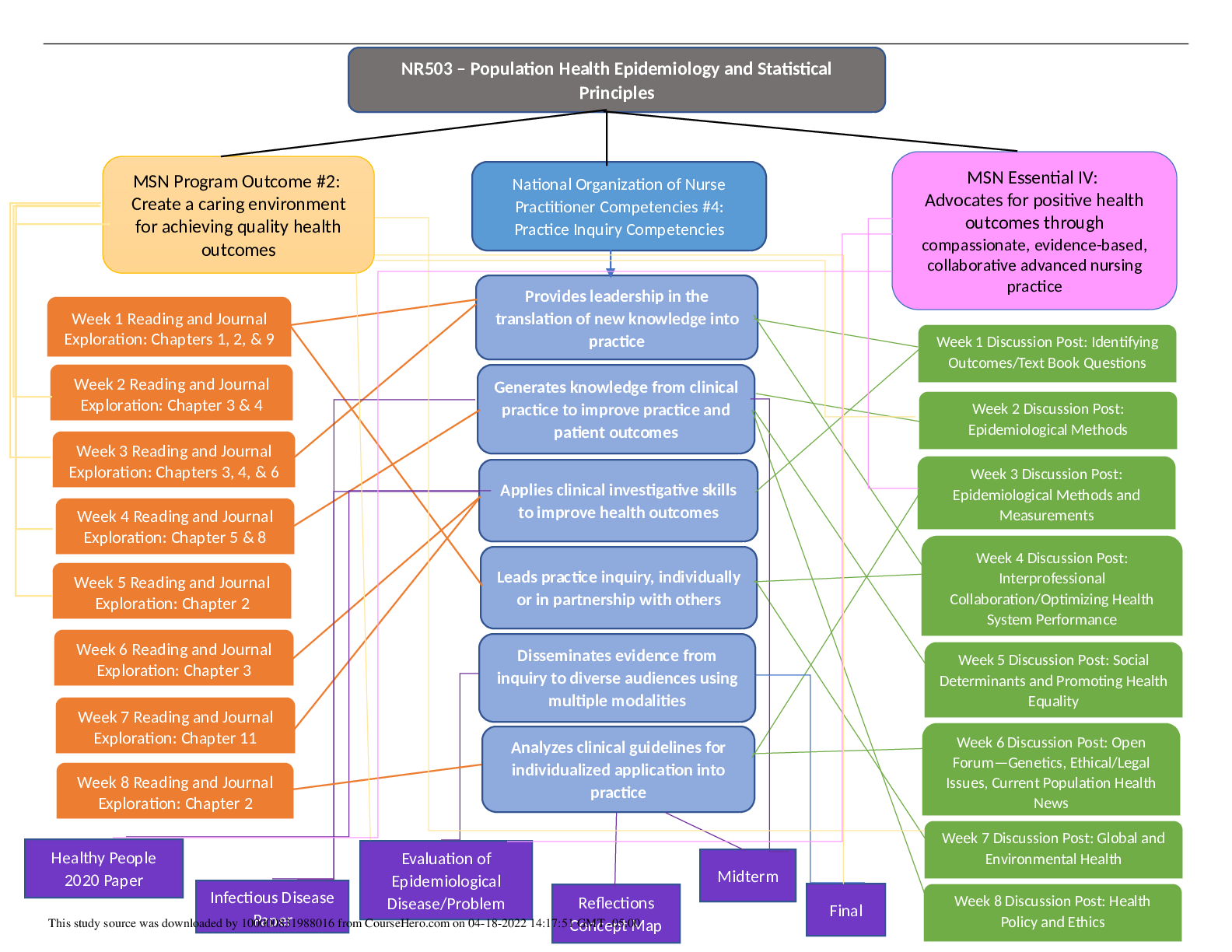

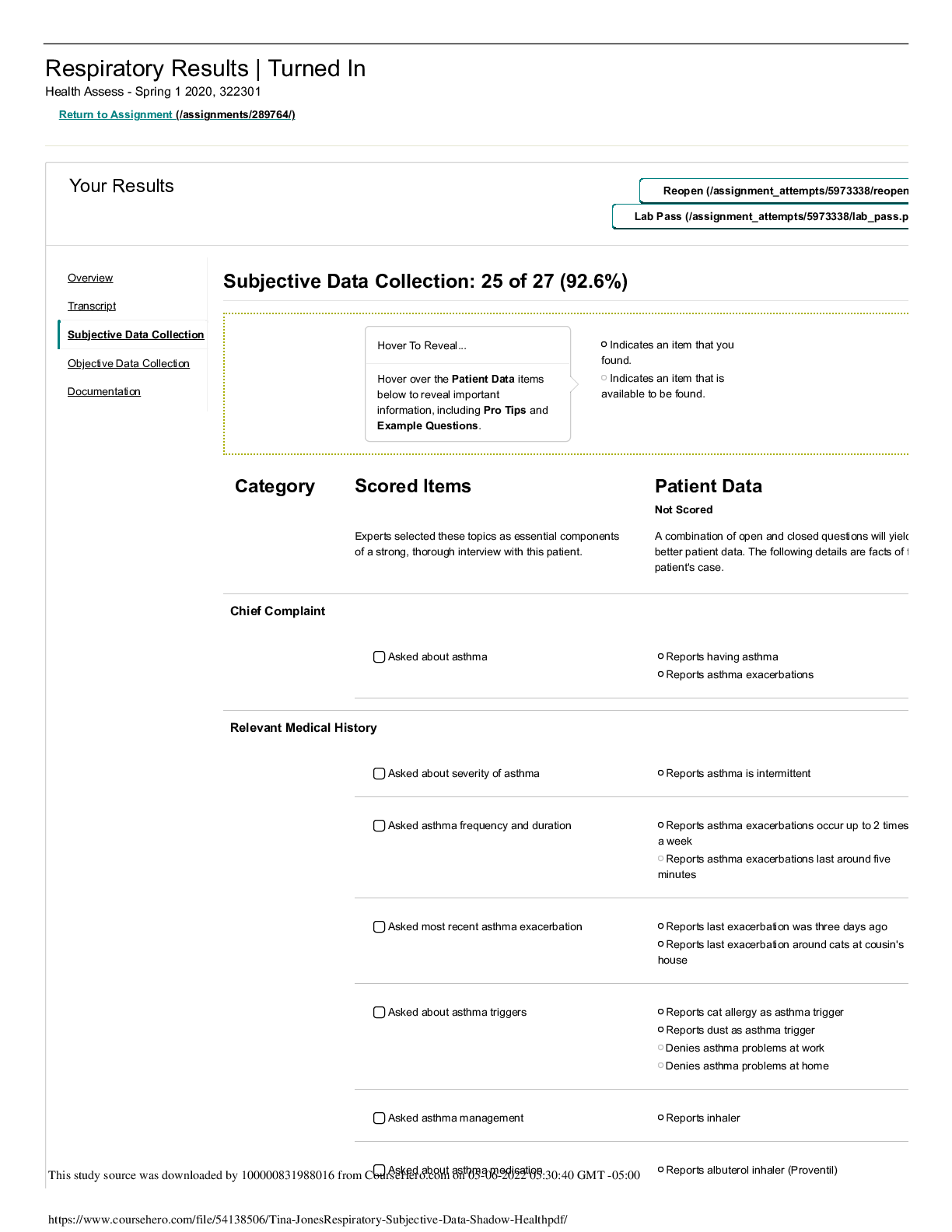
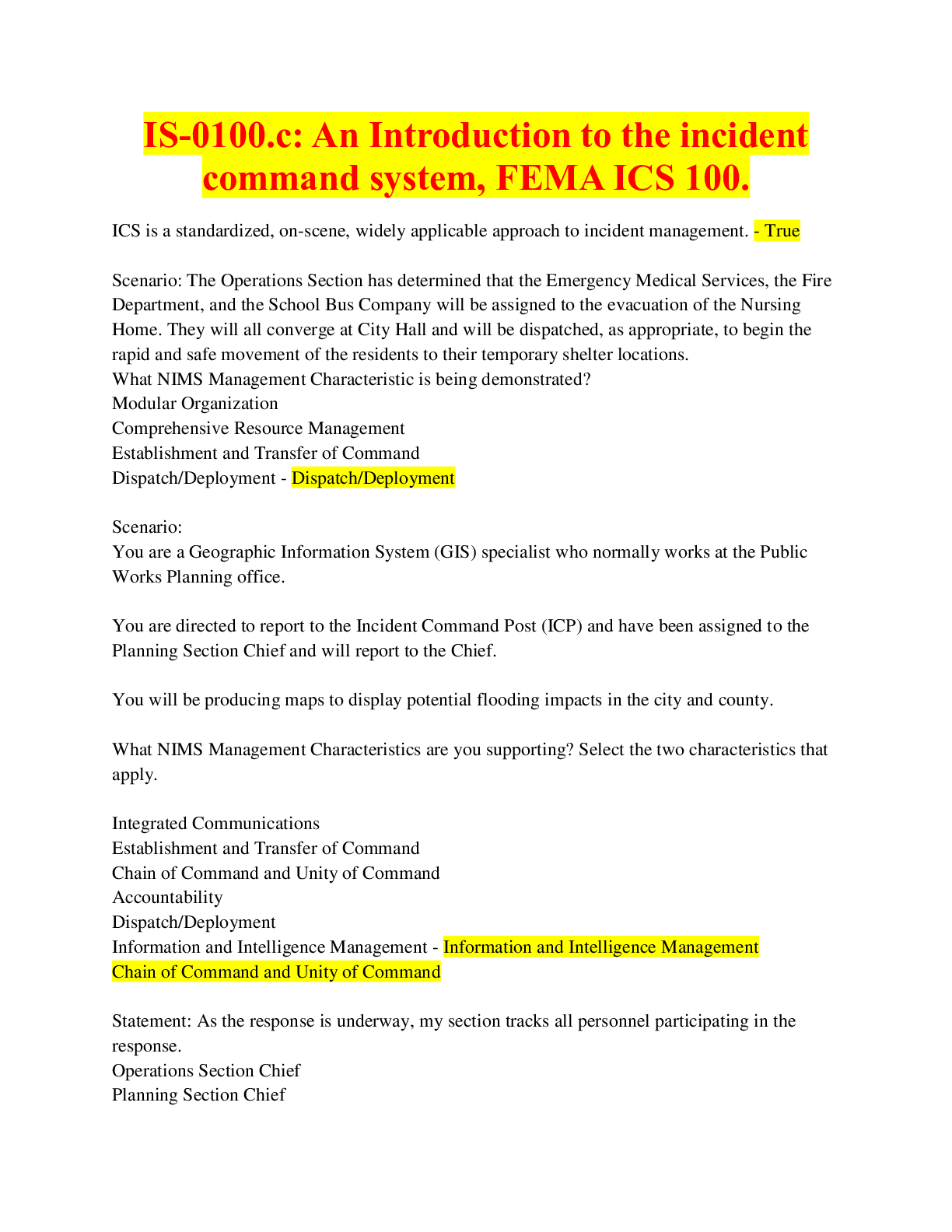



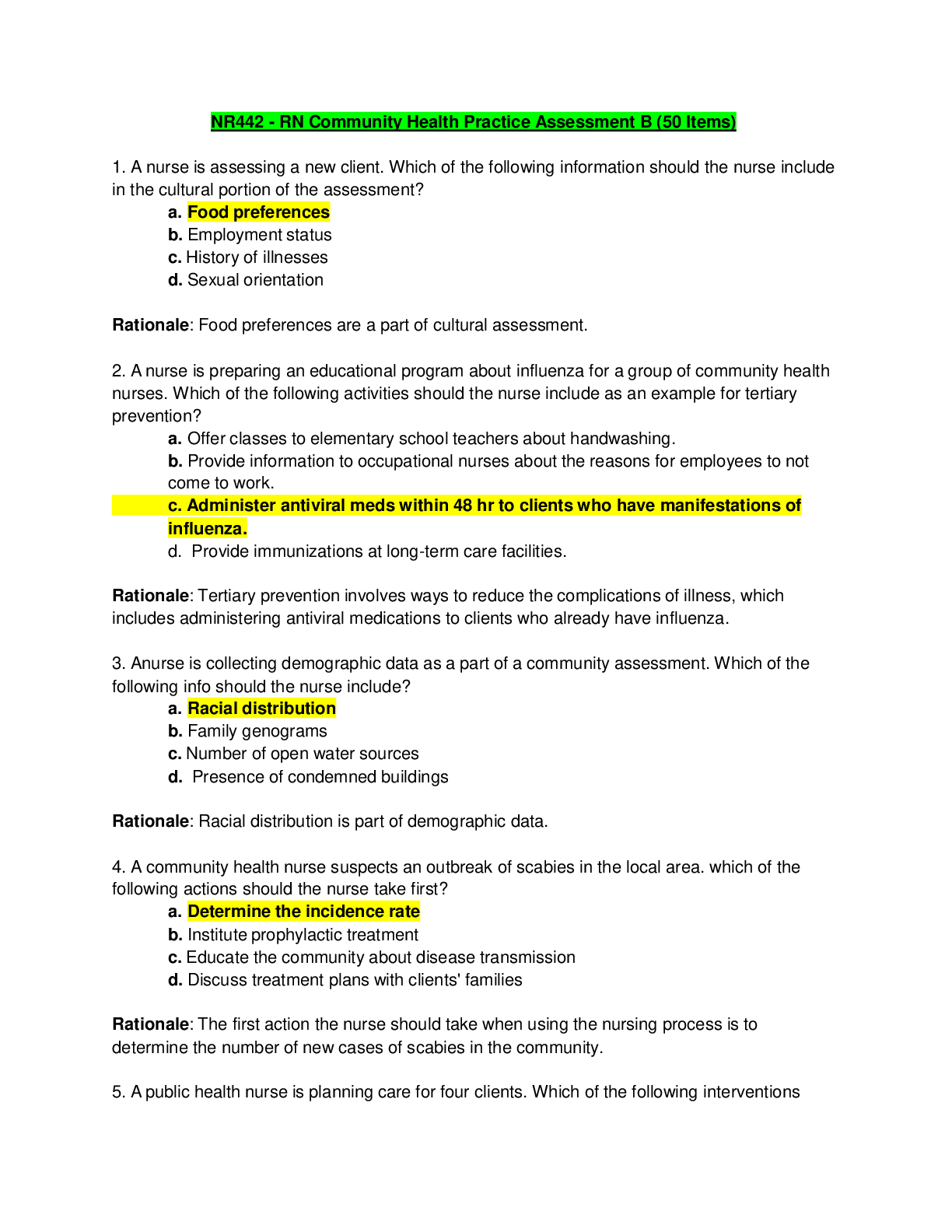


.png)
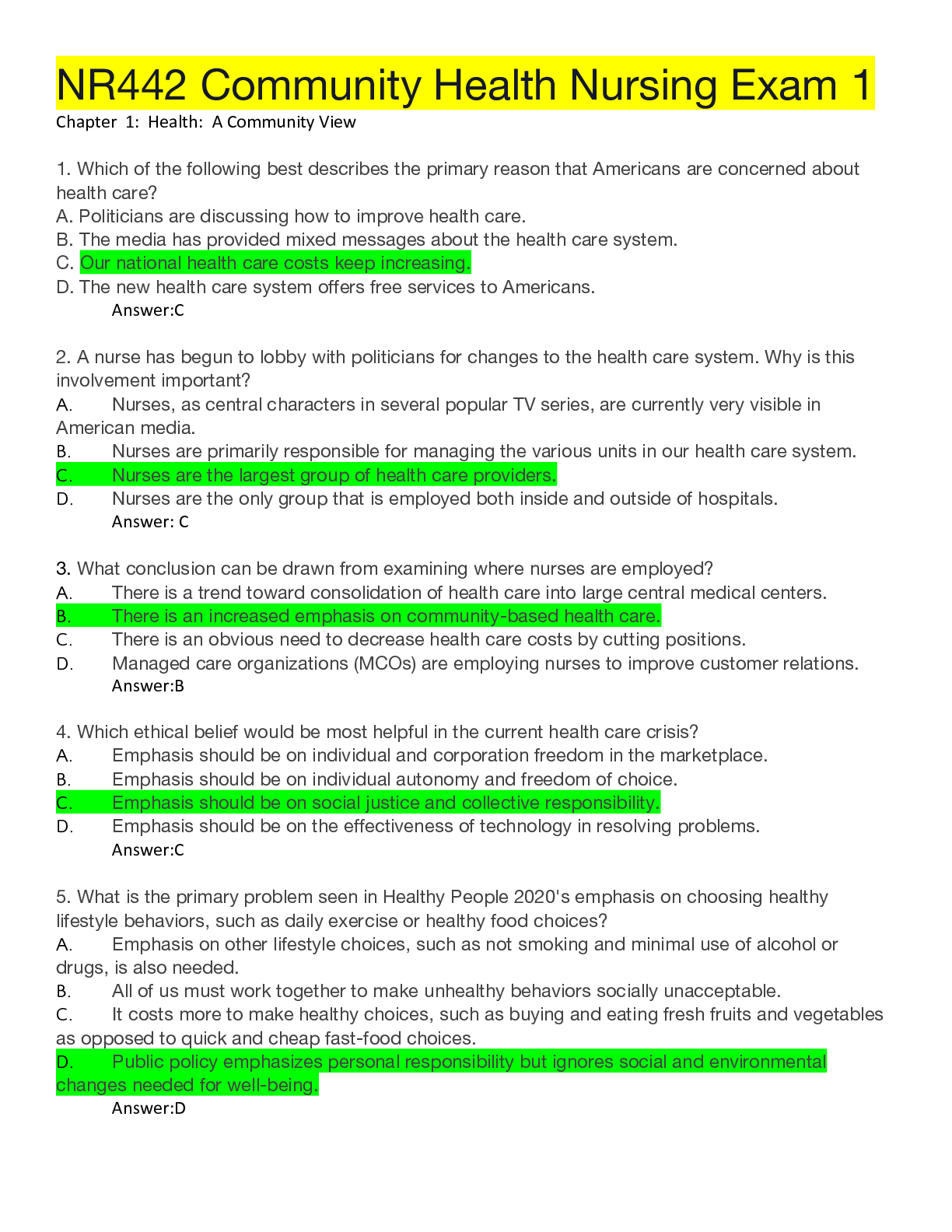

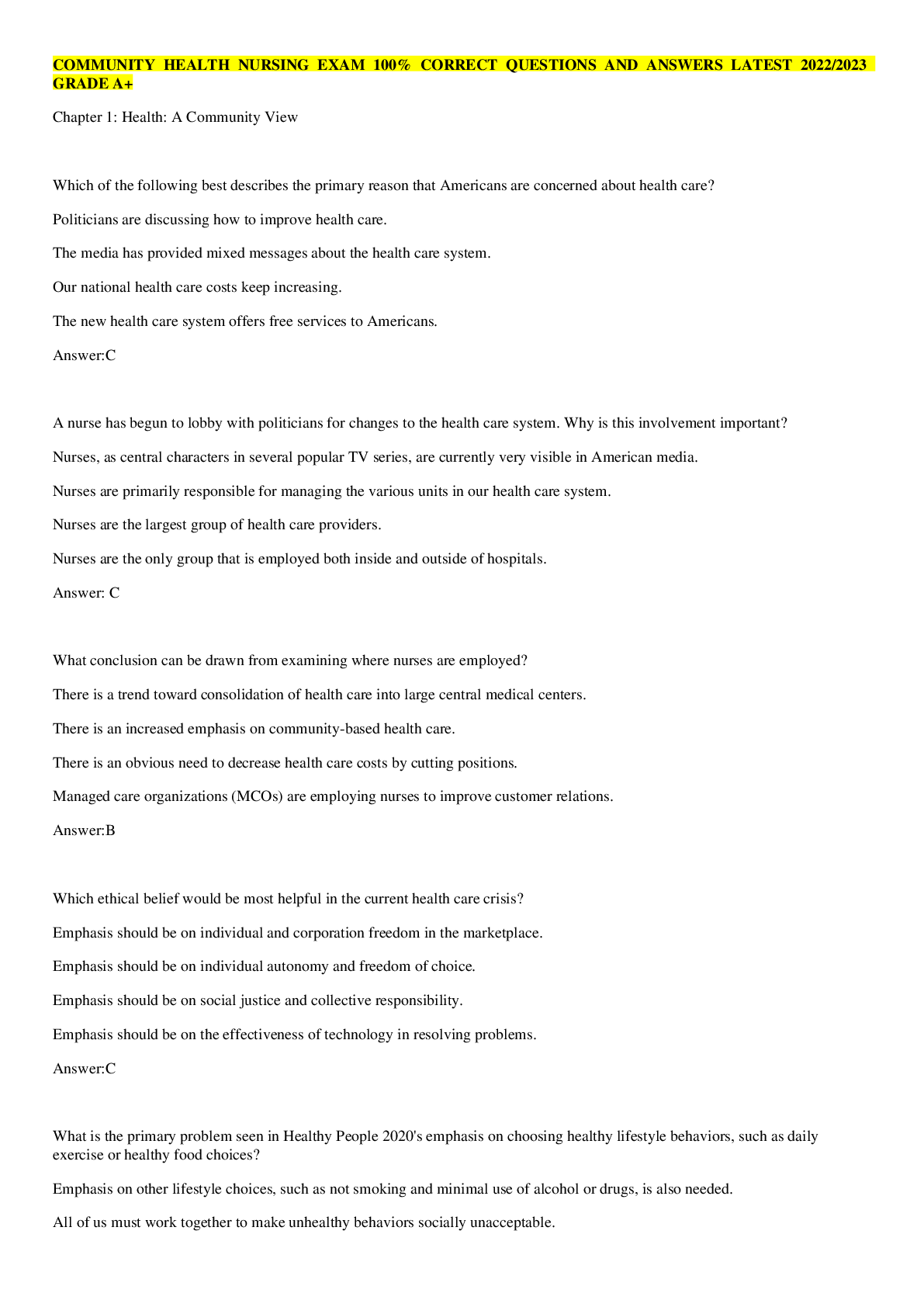


.png)

